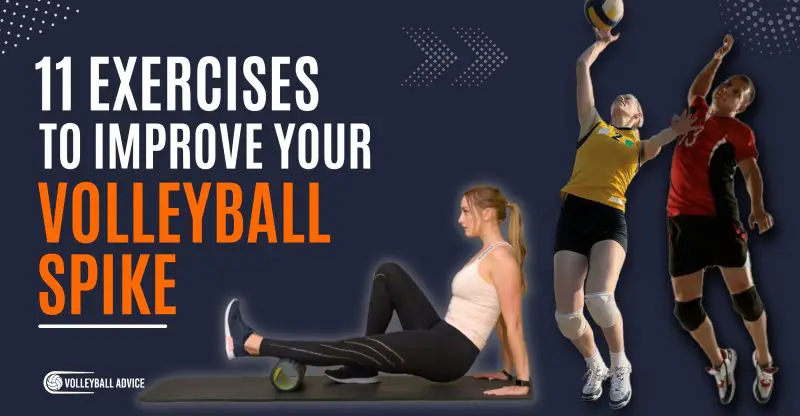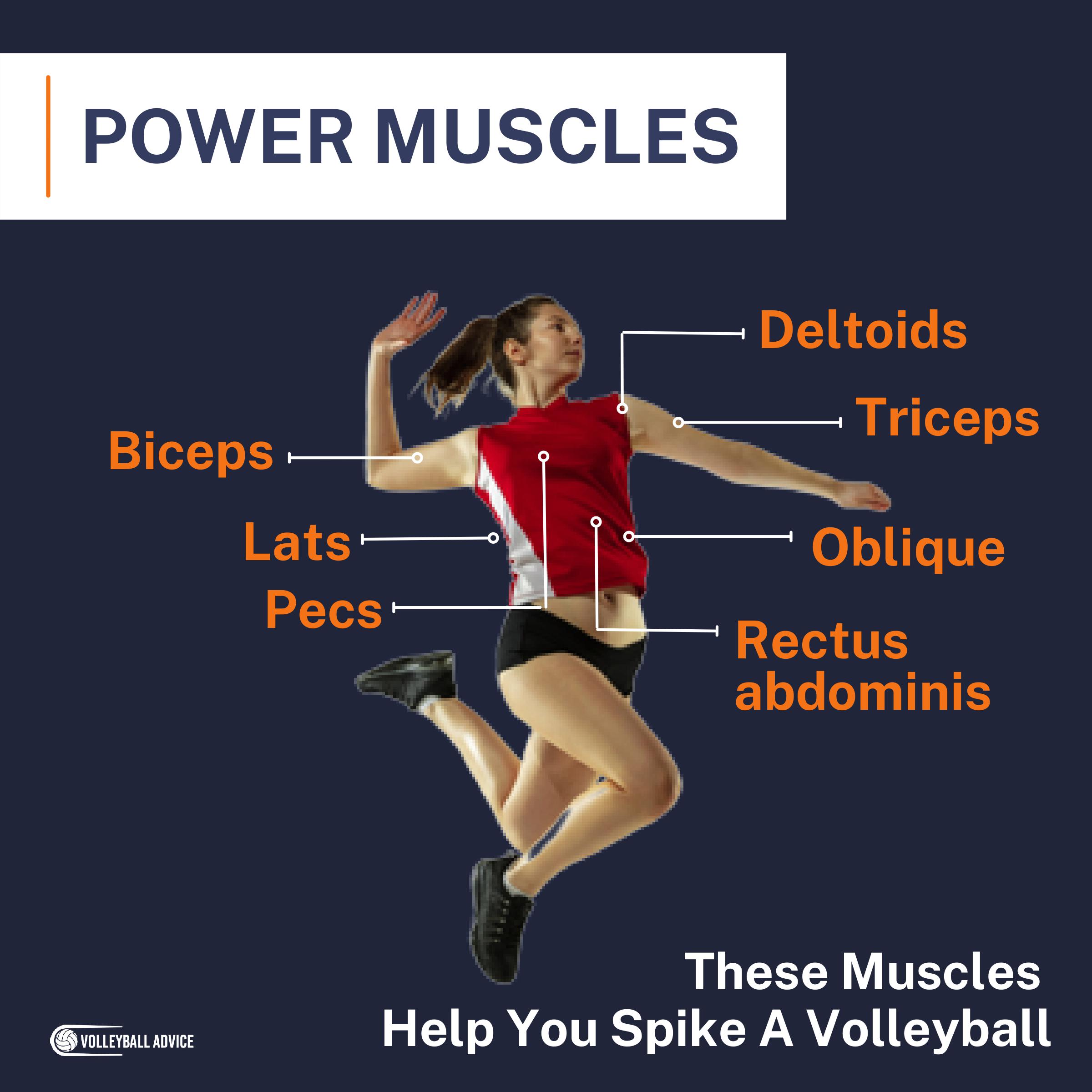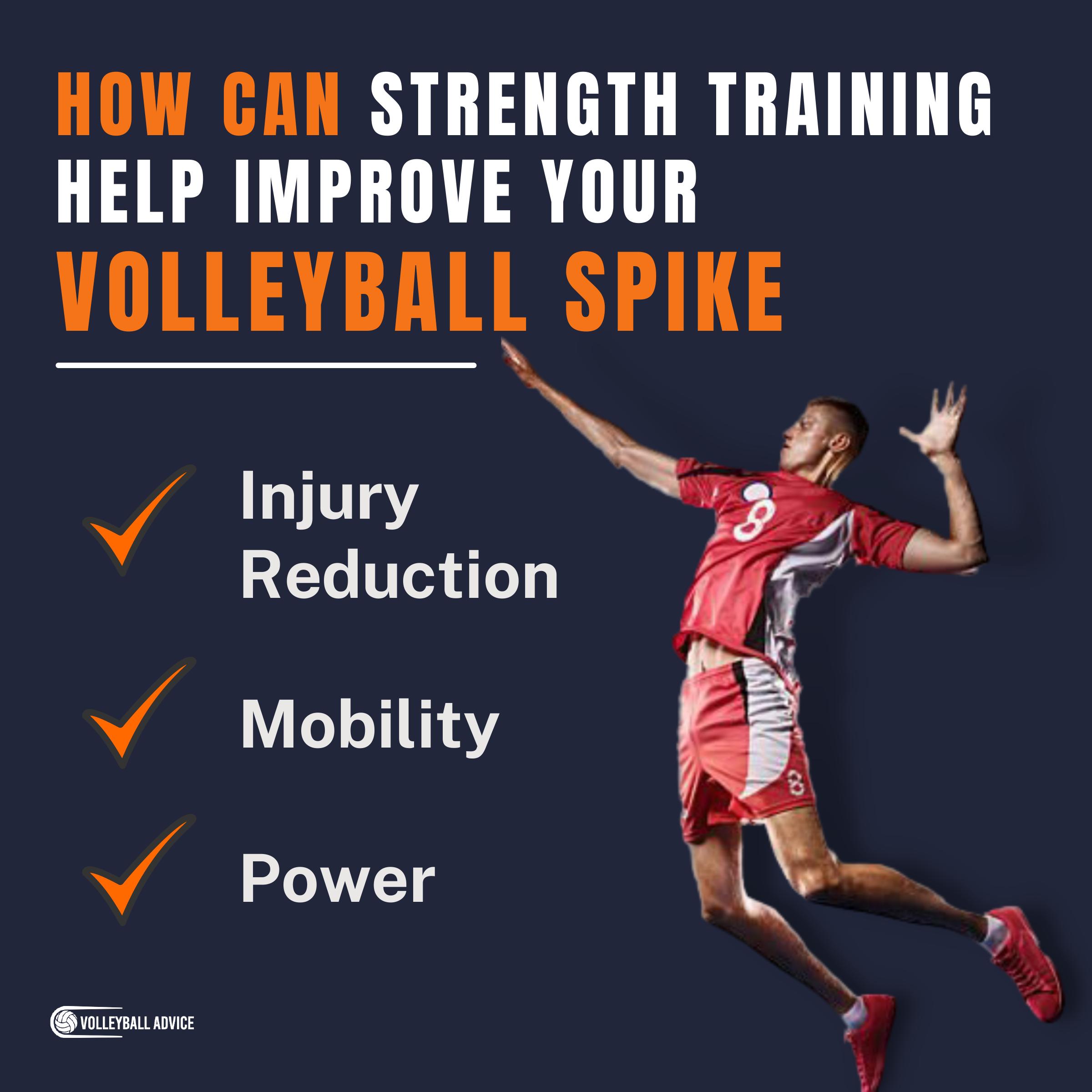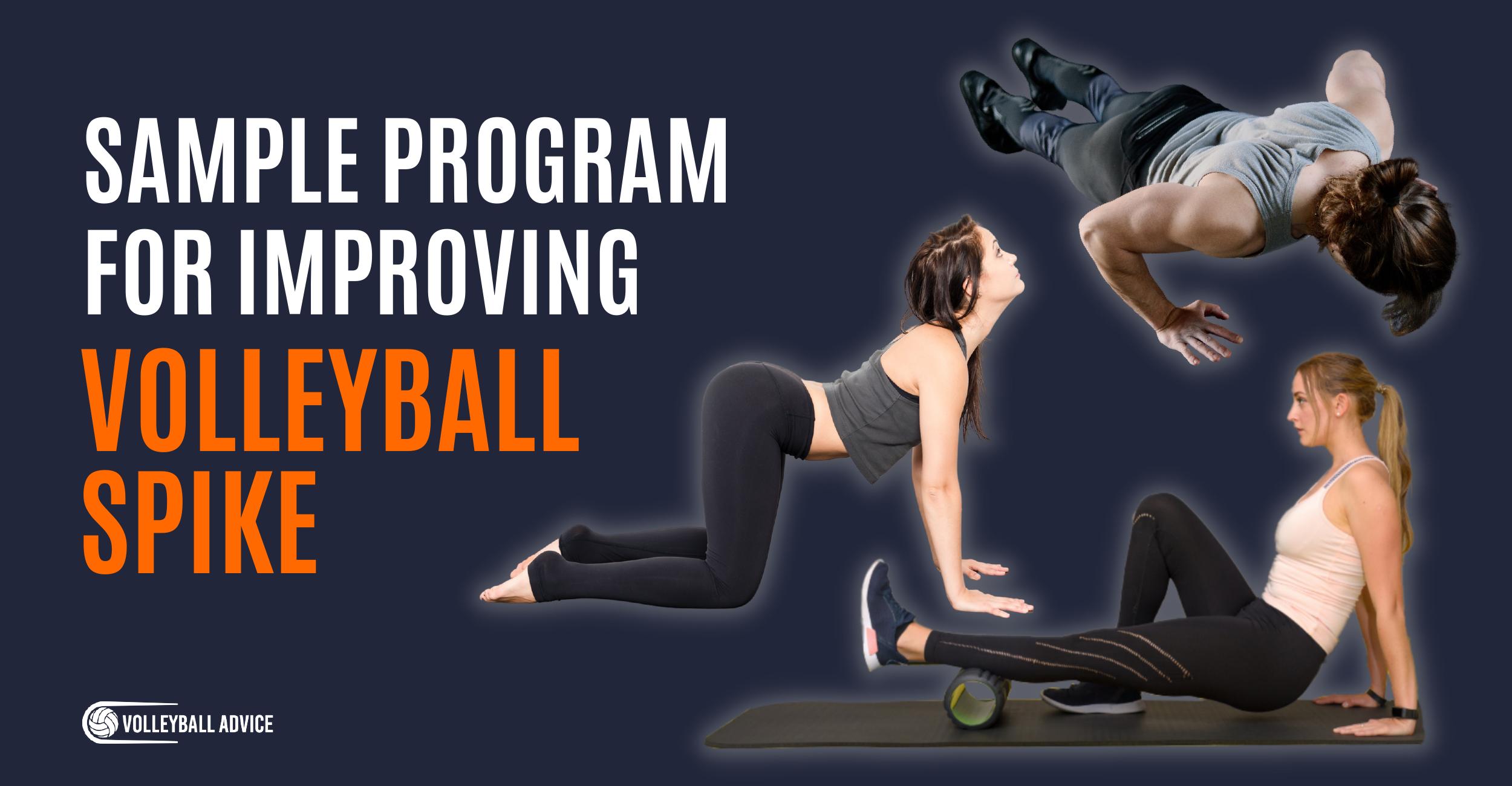11 Exercises To Improve Your Volleyball Spike
A good training plan to improve your volleyball spike will include exercises for mobility, strength, and power, for the torso and shoulder.
These are the best 11 exercises to improve your volleyball spike:
- Foam Rolling
- Cat Cow
- Quadruped T-Spine Rotation
- Wall Angels
- Wall Slides
- ½ Kneeling Cable Row
- Push Up
- Pull Up
- ½ Kneeling Medicine Ball Single Arm Chest Pass
- Single Arm Snatch
- Overhead Medicine Ball Rotational Slam
Below I’ll cover each of these exercises in detail and provide a program to help you integrate them into your volleyball strength and conditioning workouts.
What Muscles Help You Spike A Volleyball?
When spiking a volleyball you use many muscles in the body from the ones that control the eyes to the ones that control your feet. The exercises for improving your spike focus specifically on the torso and arm action for the movement.
These muscles can be divided into two categories:
1. Power Muscles
These muscles produce a lot of force very quickly. This is important as it accelerates your arm into the ball and affects the speed of your hit.
Major muscles that will accelerate your arm in the shoulder are your:
- Pecs
- Deltoids
- Lats
- Triceps
In the core, the acceleration of rotation and flexion are created from the:
- Obliques
- Rectus abdominis
- Lats
2. Stabilizing Muscles
These muscles produce force quickly as well. However, the difference between stabilizer and power muscles is their role.
The importance of the stabilizers is to slow the arm down at the end of the swing as well as help guide the direction of the arm so you contact and direct the ball where you want it to go.
Some important stabilizers in the shoulder are your:
- Rotator cuff (supraspinatus, infraspinatus, teres minor, and subscapularis)
- Traps
- Rhomboids
- Deltoids
- Biceps
In the core your obliques, lats and erectors will play a role in slowing the torso down from continuing to flex and rotate.
Related Article: 16 Types of Spiking In Volleyball
Injury Reduction
Injury reduction is an aspect of training that is preventative in measure. The chance of an injury can not be eliminated. But, by looking at common injuries and how they occur, exercises can be done to reduce the chance of that injury in future.
Above we discussed the power muscles and stabilizing muscles. Another way to think of them is gas and breaks for the arm swing. Without the breaks your arm will want to fly off your body.
Without stabilizing muscles, your body will rely on non muscular tissue like tendons and ligaments to stop this from happening.
Strength training the muscles that accelerate the arm is important for developing more arm speed and a harder hit.
However it is equally if not more important to train the muscles that slow the arm down. These muscles are what keep your shoulder tissues healthy and you able to play.
Mobility
Through repeatedly being stressed, tissues can tighten or stick to each other. This can happen from playing sports, strength training or from overall life stress. Mobility exercises help restore full range of motion in muscles and joints.
Mobility exercises are often part of a comprehensive strength training plan as well as on court warm up.
The mobility that is important to maintain for a strong spike is your shoulder and thoracic or upper back mobility.
Losing shoulder mobility will affect your technique, making you lose power. It also will affect your reach, making you less accurate if your timing or the set is slightly off.
It is important to maintain the mobility to reach overhead, in front of and behind you, with your arm.
Thoracic mobility reduces the stress on the low back. When the upper back is stiff like a cage, the low back has to compensate, which long term can turn into injury.
Keeping the upper back mobile like a spring allows you to reach overhead more easily. It also allows for greater rotation, and the ability to produce more power in your core for your spike.
The foam rolling, cat cow, quadruped t-spine rotations, wall angels and wall slide exercises will help you with your mobility (discussed further below).
Related Article: Reaction Time in Volleyball: 4 Specific Drills To Master
Power
Another way strength training can improve your spike is through power exercises. These are exercises that train your body to quickly produce a lot of force, to accelerate you.
Power production comes from two aspects of training, a muscle’s overall strength, and the nervous system’s ability to contract the muscle with speed.
Exercises like the ½ kneeling row, push up and pull up are intended to build strength in the muscles. These exercises are done until the muscles are fatigued and you are no longer able to perform the movement with proper technique.
For that reason these sorts of exercises are done with heavier weights moving slowly with control.
Exercises like ½ kneeling single arm chest pass, single arm snatch and overhead rotational slam are intended to train the power in your movements. These exercises take the strength already built in the muscle and teach you to produce it or contract the muscle with speed.
For this reason these exercises are done with lighter weights and focus on speed of movement.
Related Article: How To Spike A Volleyball If You’re Short
11 Exercises to Improve Your Volleyball Spike
1. Foam Rolling
Foam rolling is a form of self massage and will help improve range of motion. The muscles you will want to focus on for hitting are your pecs, lats, biceps and triceps.
How To
- For each muscle take 30-60s and roll back and forth over short sections (2-5cm) and work your way from one end of the muscle to the other
- Pec – Lie on your stomach with the roller under your chest on a diagonal, one end by your head, the other end by your armpit. Self Myofascial Release: Foam Rolling – Pectorals
- Lat – Lie on your side with your bottom arm extended above your head and the roller perpendicular to you and under your armpit. Self Myofascial Release: Foam Rolling – Latissimus Dorsi
- Biceps – lie on your stomach with your arm out at 90 degrees and elbow pointing to the roof.How To Stretch Biceps | Foam Roll Bicep
- Triceps – lie on your stomach with your arm reaching in front of you and the roller under the back of your arm perpendicular to the arm. Foam roller triceps release
Pro Tip
The more tense you are the less you will massage the tissue. Relax and breath trying to sink into the roller as you roll over your muscles.
2. Cat/ Cow
The cat/cow exercise helps improve your mobility through your spine. Being able to extend and flex the spine allows you to rotate the shoulders to prepare to hit and then flex the torso as you follow through.
How To
- Start on all fours with your knees under your hips and hands under your shoulders
- Breath in and press between your shoulder blades towards the roof, arching your back
- Let your breath flow out as you drop your chest towards the floor, lifting your chin for the roof
- Repeat slow and controlled, with your breath cycle
Pro Tip
Pressing your fingertips into the floor helps stabilize the shoulders. This makes it easier to focus on moving the spine and less likely the shoulders will get tired supporting you.
3. Quadruped T-Spine Rotation
T-Spine rotations help keep mobility through your thoracic spine, or upper back. This allows you to rotate the shoulders independent of the hips, helping produce more power and reduce the chances of overworking the lower back when hitting.
How To
- Start on all fours with your knees under your hips and hands under your shoulders
- Place one hand on the back of your head, with the elbow out to the side at shoulder height
- Breath in, and open up and pointing your shoulder and elbow for the sky
- Let your breath flow out as you close, rotating your torso so the shoulder and elbow point towards the ground
- Keep your hips still as your rotate with your breathing cycle
Pro Tip
Placing a roller upright beside your legs and making sure not to knock it over, is an easy way to make sure you keep your hips still as you rotate
4. Wall Angels
The shoulder blades ability to rotate and move over the rib cage, plays a huge roll in the function of the shoulder. Wall angels are a great exercise to work on this movement as well as opening up tight muscles in the chest.
How To
- Stand in front of a wall with your elbows and shoulders at 90 degrees and wrist and elbows flat on the wall
- Make sure your back is also flat on the wall. You may need to walk the feet away from the wall a bit to achieve this
- Reach overhead as far as you can keep the back, wrist and elbows on the wall
- Then, slide your elbows towards your hips bending them so your thumbs end up beside your shoulders
- Repeat reaching up and sliding down, keeping everything in contact with the wall
- If your range of motion feels limited, use your breath and relaxation to slowly gain range of motion
Pro Tip
If you have limited range of motion on a wall, try lying on your back on the floor and reaching overhead and back down in this position until your range of motion improves.
5. Wall Slides
Wall slides are another exercise for improving the stability and movement of the shoulder blade.
How To
- Stand in front of a wall with your wrists and elbows on the wall, thumbs pointing away from the wall
- Press your forearms and and outside of the hand into the wall as you reach up
- With control, slide your arms back down until they are in front of your chest
- Repeat in a smooth controlled motion, inhaling as you reach up and exhaling on the way down
- Keep your spine tall and still as you move
Pro Tip
Some people may find it easier to stand with your feet staggered, one in front of the other. Make sure you are comfortable with this movement in all three stances, left forward, right forward and feet side by side.
6. ½ Kneeling Cable Row
Rowing in this position, helps build back strength and stability in the shoulder.
Also it improves the ability to rotate the shoulders without the hips, helping the core produce more power for spiking.
How To
- Kneeling down on 1 knee. If needed place a pad under the knee, to help with comfort and to level the hips
- Lift your front foot off the ground briefly to align yourself over the back knee. The front foot is just for balance, you want to be tall and stable loaded through back knee
- Holding a band or cable, in the opposite hand to the front leg
- Drive your elbow past your side rotating your shoulders as the elbow drives back
- Control extending the arm back in front of you, allowing your shoulders to rotate to face the front leg
- If your hip bones are headlights, they should shine straight forward as you stay tall, rotating the shoulders and driving the elbow back past your side
Pro Tip
Moving the front foot towards your body or midline, challenges your core and balance more. Moving your front foot away from your midline or more to the side, makes it easier to balance and allows you to increase the load you are pulling.
7. Push Ups
Push ups train multiple muscles used for volleyball at once. Your core has to hold your spine stabilize as you plank, the shoulder stabilizers work as you raise and lower the torso, and you build strength in the pecs and triceps muscles.
How To
- Start in a high plank position with your feet hip width apart and hands slightly wider than your shoulders
- Keeping yourself long from your heels to your ears, lower your chest to the ground
- At the bottom position there should be a 45 degree angle between your torso and your arm
- Press yourself back to the start position
Pro Tip
If it is difficult to press yourself up, moving your body as one unit, not breaking in the low back/ hips, place a roller under your shins, between your knees and ankles. Then, pivot from there. The closer the roller gets to your feet, the harder it will get.
8. Pull Ups
Pull ups will improve the function and stability of the shoulder in an overhead position while building lat strength for your spike.
How To
- Grab the bar wider than shoulder width with your palms facing away from you
- Imagine you are bending the bar over your head as you drive your head up
- Control down
Pro Tip
Pull ups can be done on a railing or barbell with your feet on the ground for assistance to get more reps
9. ½ Kneeling Single Arm Chest Pass
This is a power exercise to work on producing explosive force in the pecs and core.
How To
- Kneeling down on 1 knee. If needed place a pad under the knee, to help with comfort and to level the hips
- Lift your front foot off the ground briefly to align yourself over the back knee. The front foot is just for balance, you want to be tall and stable loaded through back knee
- Hold a medicine ball in both hands with your elbows up
- Rotate so one elbow points at the wall, one behind you
- Rotate your shoulders and push the ball like you are trying to throw it through a wall
- If your hip bones are headlights, they should shine straight forward as you stay tall
Pro Tip
The purpose is to move with speed. For this reason you will want light medicine ball 2-8lbs
10. Single Arm Snatch
The single arm snatch is a technically more advanced exercise. It has two roles when it comes to spiking. It will build power for jumping in the legs and build shoulder stability.
How To
- Start in a quarter squat position
- Hold a weight in on arm
- Push the ground away and get as tall as you can through the hips, knees and ankles, like you are jumping
- Drive your elbow as high as you can so the weight comes towards your chin
- Pull yourself under the weight, extending your arm to catch it above your head
- Lower the weight to your shoulder and then back to the start position
Pro Tip
Practice some reps going through the movement with a tennis ball in your hand. If you have good technique, you will be throwing the tennis ball straight up in the air.
11. Overhead Rotational Slam
The overhead rotational slam combines the rotation of a spike with the downward action of the arm.
How To
- Stand with the feet shoulder width apart
- Hold a medicine ball overhead
- Slam it into the floor beside one foot
- Catch the ball or pick it up and return to the over head position
- Repeat on the other side.
Pro Tip
The purpose is to move with speed. For this reason you will want light medicine ball 2-8lbs.
Other Spiking Resources
- Footwork For Spiking A Volleyball: Technique, Drills, Errors
- How To Practice Spiking A Volleyball With No Net (10 Drills)
- How To Spike A Volleyball Straight Down (A Coach Explains)
Sample Program For Improving Volleyball Spike
Warm Up Mobility
Before you workout or before you play, these exercises will improve your training session and ability to spike through increased range of motion and shoulder stability.
- Foam Rolling – 30-60s per muscle
- Cat Cow – 10 breath cycles
- Quadruped T-Spine Rotations – 10 breath cycles / side
- Wall Angels – x10
- Wall Slides – x10
Power Exercises
After your warm up, while you are still fresh is when you want to do power exercises for speed and acceleration.
- Single Arm Snatch
- Overhead Rotational Slam
- ½ Kneeling Single Arm Chest Pass
Start with 3 sets of 5 reps each with 1 min rest between sets. As your technique improves, (possibly the 3rd or 4th time doing these exercises) increase the weight and move to 4 sets of 3-4 reps.
The point is to move with speed. This means the weight is too heavy if it is slowing your movement down. You will want to pick weights where you feel like little resistance to you moving.
Strength Exercises
After your power exercises you can do slower strength exercises until your muscles are fatigued.
- Pull Up
- Push Up
- ½ Kneeling Row
For all of these do 3-4 sets of 8-10 reps with 1-2min rest between sets. The first time you reach 3 sets of 10 reps, add a 4rth set in your next workout. When you reach 4 sets of 10 reps for the following workout do 4 sets of 8 with increased weight. Continue the cycle of 4 sets of 10 reps followed by decreasing to 8 reps and more weight the next workout.
Other Strength & Conditioning Articles
- How To Improve Coordination & Balance In Volleyball
- 13 Best Leg Exercises For Volleyball (Sample Program)
- How To Jump Higher in Volleyball (Science-Backed)
- 5 Best Ab Exercises for Volleyball Players (Sample Workout)
- 12 Best Volleyball Upper Body Exercises & Workouts
- 5 Shoulder Exercises for Volleyball Players
- 9 Power Exercises For Volleyball Players (Sample Program)
- 7 Best Arm Workouts For Volleyball Players
- Sprint Workouts For Volleyball (6 Examples)
Final Thoughts
Spiking a volleyball usually combines jumping with the lower body while coordinating an arm swing in the upper body.
When training the arm swing portion you want to develop mobility, strength and power.
The mobility gives you a greater range of motion to accelerate through, more strength increases the force you can produce and more power means you can accelerate your arm faster.
Strength in your shoulder stabilizers will also help you slow down the arm and reduce your chance of injury.
The sample program given will help you with all of these aspects.
About The Author
Ian started his strength and conditioning career working with elite youth volleyball athletes. Before coaching, he completed a BSc in Biomechanics at the University of Calgary. He has over a decade of experience working as a kinesiologist and strength and conditioning coach, with teens to octogenarians in positions with community gyms to elite sport. Outside of coaching, you can find Ian learning new sports, skiing, river surfing, hiking, and traveling. If you have questions or are interested in opportunities to work with Ian, connect with him via Instagram, Linkedin, or Website.





